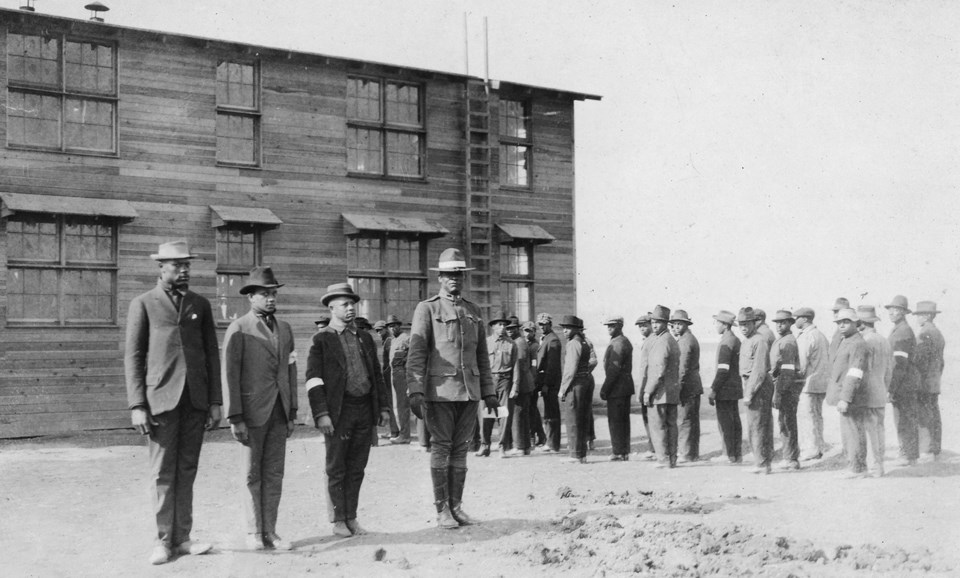"Let us, while the war lasts, forget our special grievances & close ranks shoulder to shoulder with our white fellow citizens and the allied nations that are fighting for democracy. We make no ordinary sacrifice, but we make it gladly & willingly." W.E.B. DuBois, The Crisis, July 1918
Article
The Buffalo Soldiers in WWI

U.S. Army
A Declaration
On April 6th, 1917, the United States officially entered World War I as Congress swiftly passed a Declaration of War against Germany. Many African Americans expected the regular Army troopers of the Buffalo Soldiers to be part of the American Expeditionary Forces (AEF) sent to France to battle the Kaiser. However, behind closed doors, politicians and high-ranking members of the military saw to it that the four regular Army Buffalo Soldier regiments were conveniently dispatched to inconvenient locales throughout the central U.S. and even into the Pacific. In fact, the highest ranking African American officer of the time, Lieutenant Colonel Charles Young, was deemed medically unqualified and forced into retirement shortly after the U.S. entered the Great War.
The 9th Cavalry were already dispatched in the Philippines, the 10th Cavalry was patrolling the U.S. & Mexico border, the 24th Infantry was also on the Mexico border and the 25th infantry was stationed in Hawaii. None of the regular Army Buffalo Soldier regiments ever saw duty with the AEF in France during WWI. As hard as those in power fought to prevent African Americans from serving in any major capacity during the war, the demand for manpower quickly demonstrated to all that in order to defeat the Axis, more men would be needed regardless of their color. While the regular Army Buffalo Soldiers were exiled away from WWI action, the National Army would eventually have to conscript tens of thousands of additional African Americans to join the fight for democracy in the Great War.

Buffalo Soldiers and Blue Helmets
The U.S. organized two divisions of segregated men, the 92nd Division and the 93rd Division for WWI. The 92nd would carry the name “Buffalo Soldiers” as their nickname and the 93rd would be known as the “Blue Helmets.” Even though these African Americans established an African American presence in the AEF, American leaders at the top would still shun them. Much of the 92nd would be relegated to logistics and support, behind the front lines. When both divisions arrived in France, General John "Black Jack" Pershing was more than willing to lend both divisions to the French army to fight under the French command and flag. Parts of the 92nd would see combat action in France while mostly all of the 93rd would fight in combat. These African-American soldiers would wear the American uniform, but would don the blue French helmet and utilize French military equipment. They quickly dispelled the American Army’s belief that they were inferior soldiers as they heroically and valiantly fought in fierce combat throughout the war. As a result of their actions, France would award several honors and medals upon multiple regiments in both divisions. Some of these noble awards were equivalent to the U.S. Medal of Honor. Several soldiers from both divisions received the coveted French Croix de Guerre (Cross of War) medal for their exemplary and heroic fighting during WWI. It would take more than seven decades after the war for the United States to confer two Medals of Honor to two African-American soldiers for their heroism and selfless service. Corporal Freddie Stowers for his actions on September 28th, 1918 posthumously received his medal on April 24th, 1991 and Sergeant Henry Johnson for his actions on May 15th, 1918 posthumously received his medal on June 2nd, 2015. Both men served in the 93rd Division.
Read the complete Summary of Operations in The World War for the 92nd Division and the 93rd Division as prepared by the American Battle Monuments Commission which documents the operations of each division during their time in WWI France.
"Corporal Stowers' conspicuous gallantry, extraordinary heroism, and supreme devotion to his men were well above and beyond the call of duty, follow the finest traditions of military service, and reflect the utmost credit on him & the U.S. Army." Final sentence on Corporal Freddie Stower's Medal of Honor citation.
Ohio Trained
The Army built 32 training camps, or cantonments, throughout the country to train soldiers for war. Sixteen were constructed for Regular Army recruits and sixteen for National Army recruits. One of the large cantonments was built in south-central Ohio; Camp Sherman in Chillicothe, Ohio. Part of Camp Sherman was constructed on the site of present-day Hopewell Culture National Historical Park. Camp Sherman construction began in June of 1917 and by early September, new recruits were reporting for duty. A few regiments of African-American soldiers would be trained at Camp Sherman. The 317th Engineers Regiment, 317th Engineers Train and the 325th Field Signal Battalion were organized and trained at Camp Sherman before shipping out to join the 92nd Division in France. The all African-American 813th Pioneer Infantry regiment was also organized and trained at Camp Sherman and would wind up with the U.S. Second Army in France in 1918.
Read more about Camp Sherman and the impact it had on the south-central Ohio area and other stories from the legendary cantonment.

National Archives
National Parks and the Great War
World War ILast updated: October 26, 2022
